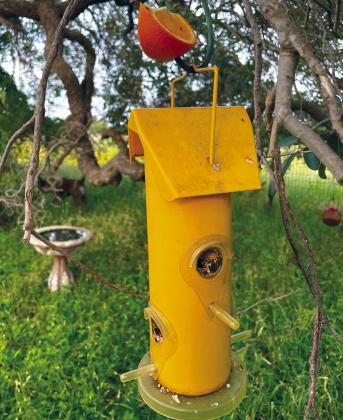Master’s Garden
Black mold on hummingbird feeders can be a common issue, especially in warm and humid conditions.
This mold often develops in the sugar water (nectar) solution when it’s not changed frequently or when the feeder is not cleaned regularly.
To address this problem, it’s important to clean the feeder thoroughly every 3-4 days using a mixture of hot water and white vinegar or dawn.
Use a bottle brush or other cleaning tools to scrub the interior of the feeder and remove any mold or residue. Avoid using harsh chemicals, as these can be harmful to hummingbirds.
Additionally, make sure to change the nectar in the feeder every 3-4 days, even if it hasn’t been entirely consumed by the hummingbirds, to prevent fermentation and mold growth. By maintaining a clean hummingbird feeder and regularly replacing the nectar, you can provide a safe and healthy feeding environment for hummingbirds and prevent the growth of black mold.
Orange You Nice
To attract orioles to your backyard, offering orange slices and grape jelly can be an effective and enticing strategy. Orioles are particularly drawn to the sweet and citrusy flavors of oranges and grape jelly.
To attract them, slice oranges into halves or wedges and place them on a feeder or a tray where orioles can easily access them. Similarly, provide small dishes of grape jelly, preferably in a shallow container or specialized oriole feeder. Ensure that the oranges and jelly are fresh and replenish them regularly, especially in warmer weather when they can spoil quickly.
Position these offerings in a visible and safe location within your yard, ideally near trees or shrubs where orioles can perch and feel secure while feeding.
Grape Escape
Orioles are attracted to jelly because it provides them with a concentrated source of energy in the form of sugar. Grape jelly, in particular, contains high levels of sucrose, which is a type of sugar that orioles readily consume. In the wild, orioles primarily feed on nectar, fruits, and insects, all of which are natural sources of sugars and carbohydrates. Grape jelly mimics the sweetness of ripe fruits and flowers, making it a desirable and easyto- access food source for orioles, especially during migration or breeding seasons when they require extra energy.
Offering grape jelly in feeders allows orioles to quickly replenish their energy reserves, making it a popular and effective food option for attracting these beautiful birds to backyard feeding stations.
P.S. If you are using S hangars for your outdoor bird feeders, you can stick the orange wedge onto the end. This also prevents the squirrels from knocking your bird feeder to the ground. Win Win.
May Duties
1. For fleas and ticks: our wonderful soldiers, the beneficial nematodes. When the ground is dry, apply diatomaceous earth. Sulfur works great for chiggers, applying elemental sulfur at 4lbs per 1000 sq ft.
2. Plant tropical col- ors: allamanda, bougain villea, hibiscus, mandevilla, and penta.
3. Warm season an- nuals to plant: begonias, caladiums, cosmos, impatiens, lantana, periwinkle, and zinnias.
4. Perennials such as asters, cannas, gladiolas, mums, summer bulbs. Put some other fall perennials in the ground.
5. Don’t wash your hands yet. We can also plant hot-weather vegetables, any and all of the herbs.
6. Add to your compost pile and turn it.
7. Remember our avian friends. Keep an eye on your bird feeders making sure there aren’t some stuck seeds molding or sprouting because of the moist air.
8. Prune spring flow ering shrubs, vines and roses that bloom only in the spring.
9. DO NOT prune red or live oaks unless they are damaged. No oak wilt wanted.
10. "Dead head" flow ering plants. Pinch off the top of a spent bloom and drop it into the pot or ground for nutrients.
11. Fertilize your bougainvilleas with high nitrogen (or coffee/tea).
Till next time, Keep your souls and soles in your garden. Remember the True Master Gardener: Jesus said, “I am the vine; my Father is the Gardener.” John 15:1 Have questions or comments? Contact Martelle at Luedecke Photography (512) 769-3179 or email luedeckephotography@gmail.com or email Bill at bill@texasland.net.





